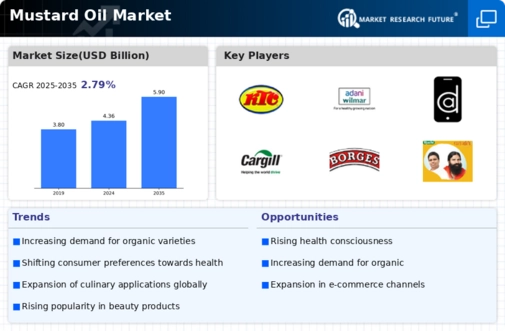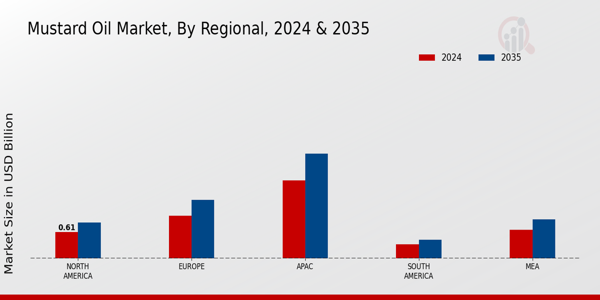Culinary Versatility
The culinary versatility of mustard oil is a key driver in the Mustard Oil Market. It is widely used in various cuisines, particularly in Asian and Indian cooking, where it is favored for its distinct flavor and aroma. The oil's ability to enhance the taste of dishes makes it a staple in many households. Additionally, mustard oil is utilized in pickling and as a base for salad dressings, further broadening its application. The growing interest in diverse culinary experiences among consumers is likely to bolster the demand for mustard oil. As more people experiment with international recipes, the Mustard Oil Market may witness an uptick in consumption, reflecting a shift towards more adventurous cooking practices.
Health Benefits of Mustard Oil
The Mustard Oil Market is experiencing a surge in demand due to the increasing awareness of health benefits associated with mustard oil. Rich in monounsaturated fats and omega-3 fatty acids, mustard oil is perceived as a healthier alternative to other cooking oils. Studies indicate that mustard oil may help in reducing cholesterol levels and improving heart health. As consumers become more health-conscious, the preference for oils that offer nutritional advantages is likely to drive growth in the mustard oil sector. Furthermore, the market is projected to expand as more individuals seek natural and organic food products, with mustard oil being a prominent choice. This trend suggests that the Mustard Oil Market could see a significant increase in sales as health benefits become a primary consideration for consumers.
Rising Demand for Natural Products
The Mustard Oil Market is benefiting from a rising demand for natural and organic products. Consumers are increasingly seeking oils that are free from artificial additives and chemicals, leading to a preference for natural oils like mustard oil. This trend is supported by a growing body of research that highlights the advantages of using unrefined oils in cooking. The market for organic mustard oil, in particular, is expanding as consumers become more discerning about their food choices. According to recent data, the organic segment of the mustard oil market is expected to grow at a compound annual growth rate of over 10% in the coming years. This shift towards natural products is likely to drive innovation and product development within the Mustard Oil Market.
Cultural Significance and Tradition
Cultural significance plays a pivotal role in the Mustard Oil Market, particularly in regions where mustard oil has been a traditional cooking medium for generations. In many cultures, mustard oil is not only a culinary staple but also holds symbolic value in various rituals and festivals. This deep-rooted cultural connection ensures a consistent demand for mustard oil, as it is often preferred over other oils for traditional dishes. The preservation of culinary heritage is likely to sustain the market, as families continue to pass down recipes that utilize mustard oil. As globalization increases, the Mustard Oil Market may also see a rise in interest from consumers outside traditional markets, who are curious about authentic cooking practices.
Innovations in Packaging and Distribution
Innovations in packaging and distribution are emerging as significant drivers in the Mustard Oil Market. As consumer preferences evolve, companies are adapting by offering mustard oil in convenient and eco-friendly packaging. The rise of e-commerce platforms has also transformed distribution channels, making mustard oil more accessible to a broader audience. Enhanced packaging not only preserves the quality of the oil but also appeals to environmentally conscious consumers. Furthermore, the introduction of smaller, single-use packages caters to the needs of modern consumers who prioritize convenience. This shift in packaging and distribution strategies is likely to enhance the visibility and availability of mustard oil, thereby contributing to the growth of the Mustard Oil Market.





















Leave a Comment